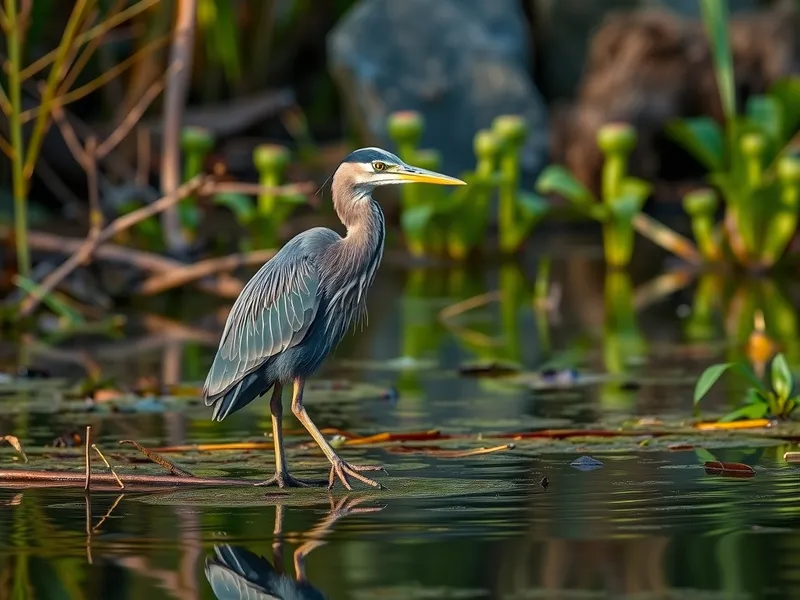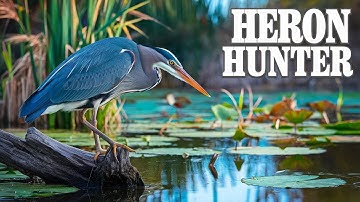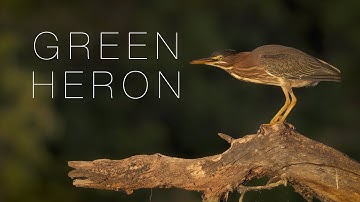
Green Heron
Butorides virescens

Meet the Green Heron
The Green Heron is a small, stocky wading bird known for its striking greenish-black cap, rich chestnut body, and greenish back and wings. Found across North and Central America, it frequents wetlands, ponds, and streams, often lurking quietly at the water's edge. This clever bird is notable for its use of tools, sometimes dropping insects or other bait onto the water's surface to attract fish. Despite its shy and secretive nature, the Green Heron is a skilled hunter and agile flyer. Its compact size and cryptic plumage make it well-adapted for solitary hunting in dense vegetation.
Classification
Bird
Habitat
Freshwater wetlands and forested ponds
Diet
Carnivore
Lifespan
5-8 years
Conservation
Least Concern
Weight
210-250 grams
📖Fascinating Facts
Tool-Using Hunter
Green Herons sometimes drop bait, such as insects or bread, onto the water to attract small fish within striking distance.
Secretive Lifestyle
They are solitary, secretive birds often remaining motionless for long periods, making them difficult to spot despite their widespread range.
Impressive Neck Extension
Despite their compact appearance, Green Herons can rapidly extend their necks to snatch prey with remarkable speed.
📋Detailed Description
The Green Heron (Butorides virescens) is a small, compact wading bird measuring 41–46 cm (16–18 in) in length, with a wingspan of 64–68 cm (25–27 in) and weighing between 210–250 grams (7.4–8.8 oz). Adults display a striking combination of deep greenish-black on the crown and back, rich chestnut on the neck and chest, and slate-gray wings edged with green. The bill is long, straight, and dagger-like, adapted for spearing prey, and the legs are relatively short and yellow to orange, becoming brighter during the breeding season. Juveniles are browner with streaked underparts and lack the adults' vivid coloration. Green Herons are secretive and solitary, often remaining motionless at the water's edge, blending into their surroundings thanks to their cryptic plumage. Their vocalizations include a sharp 'skeow' or 'kyow' call, often given in flight or when alarmed. They are highly adaptable, occupying a range of wetland habitats including marshes, swamps, mangroves, forested ponds, and even urban water features. Notably, Green Herons are among the few bird species known to use tools, dropping bait such as insects, feathers, or twigs onto the water to lure fish within striking distance. Their diet is diverse, consisting primarily of small fish, but also including amphibians, crustaceans, insects, and occasionally small mammals or reptiles. The species is generally non-migratory in the southern parts of its range, but northern populations migrate to Central America and northern South America for the winter.
💡 Did you know?
Green Herons have been observed using bread, insects, feathers, or other objects as bait to catch fish—a rare example of tool use in birds.
🔬Research & Sources
Wikipedia Summary
The green heron is a small heron of North and Central America. Butorides is from Middle English butor "bittern" and Ancient Greek -oides, "resembling", and virescens is Latin for "greenish".
Last Modified: 5/26/2025
🎭Behavior & Social Structure
Green Herons are primarily crepuscular, foraging during dawn and dusk, although they may also hunt during the day, especially in shaded areas. Their hunting strategy is characterized by patience and stealth: they stand motionless or move slowly along the water’s edge, waiting to ambush prey. The use of bait—such as dropping insects, bread crumbs, or other objects onto the water's surface to attract fish—is a remarkable example of tool use, documented in both wild and captive individuals. Green Herons are generally solitary outside the breeding season, aggressively defending feeding territories from conspecifics and other wading birds. They are agile flyers, capable of rapid, direct flight with deep wingbeats. When disturbed, they often give a sharp alarm call and fly low over the water to nearby cover. Roosting typically occurs in dense vegetation near water, and they may use the same roosting sites repeatedly.
👶Reproduction & Life Cycle
Green Herons are seasonally monogamous, forming pairs for the duration of the breeding season, which typically spans from March to July in North America. Courtship involves displays such as neck stretching, bill snapping, and plumage fluffing by the male. Both sexes participate in nest building, constructing a loose platform of sticks, usually 1–6 meters (3–20 ft) above water in shrubs or trees. Clutch size ranges from 2 to 6 pale blue-green eggs. Incubation lasts about 19–21 days and is shared by both parents. After hatching, both parents feed the chicks by regurgitation. The young fledge at around 16–17 days but may remain dependent on the parents for food for several more weeks. Double brooding is possible in southern populations with longer breeding seasons.
🛡️Adaptations & Survival
Green Herons exhibit several adaptations for their semi-aquatic lifestyle. Their cryptic coloration provides camouflage among reeds and foliage, aiding both in predator avoidance and in ambushing prey. The long, sharp bill is specialized for rapid, precise strikes at fish and other aquatic prey. Their relatively short legs and stocky build allow for stability on narrow perches and in dense vegetation. The species’ intelligence is evident in its use of tools—a rare trait among birds—demonstrating problem-solving abilities and behavioral flexibility. Their eyes are positioned to provide excellent binocular vision for depth perception, crucial for accurately targeting prey beneath the water’s surface.
📚Research Sources
🎨Cultural Significance
While the Green Heron does not have the extensive mythological or symbolic presence of larger heron species, it is admired by birdwatchers for its intelligence and elusive behavior. Its tool-using abilities have been featured in nature documentaries and educational materials, highlighting avian cognition. In some Native American traditions, herons in general are seen as symbols of patience and determination, qualities exemplified by the Green Heron’s hunting style. The species is sometimes referenced in local folklore as a clever or cunning bird.
🔬Recent Research & Discoveries
Recent research has focused on the cognitive abilities of Green Herons, particularly their use of bait and tools, contributing to the broader understanding of avian intelligence and behavioral innovation. Studies have documented geographic variation in tool use, suggesting a capacity for learning and cultural transmission of behaviors. Ongoing research is examining the impacts of urbanization and wetland management on Green Heron breeding success and population dynamics. Genetic studies have clarified the relationship between Butorides virescens and closely related species, such as the Striated Heron (Butorides striata), supporting their distinction as separate species. Monitoring programs continue to track population trends in response to environmental changes.
🎥Wildlife Videos

Green Heron * On the Hunt #greenheron
Beautiful Green Heron scouring the riverside for some tender vittles. #greenheron#sauvieisland#oregonwildlife#wildlife.
Wildlife Theater

Wetland Hunter : A Green Heron Spotlight
Join us on an immersive journey into the world of Wetland Hunter, where we delve into the fascinating realm of the Green Heron.
The Aquatic News Network

The Clever Fishing Tactics of the Green Heron
Discover the remarkable fishing tactics employed by the Green Heron, a savvy bird known for its intelligence and adaptability ...
The Sharp Claws

Avian Reveries: Green Heron
The beautiful green heron. People often ask why they are called green herons when they don't look green at all. Well, as this ...
Ryan Mense

Green Heron: the perfect hunter
This video was made during a three month period which has never happened in my 40 years of filming wildlife. A friend of mine ...
Gerald Krausse

The Unique Fishing Tactics of the Green Heron
Discover the remarkable fishing tactics of the Green Heron, a small but skilled wading bird known for its innovative hunting ...
ANIMAL ANTICS
🌍Habitat Information
The Green Heron typically inhabits Freshwater wetlands and forested ponds environments. Green Herons have adapted to their environments with specialized features and behaviors.
Primary Habitat:
Freshwater wetlands and forested ponds
More detailed habitat information will be available soon.
🛡️Conservation Status
The Green Heron is currently classified as Least Concern. Conservation efforts are crucial for preserving this species for future generations.
Common Threats:
- 🏠Habitat loss and fragmentation
- 🌡️Climate change impacts
- 🎯Hunting and poaching
- 🏭Human-wildlife conflict
⚠️Threats & Conservation Challenges
Currently, the Green Heron is classified as Least Concern by the IUCN, with stable global populations. However, local declines have been observed in areas where wetland habitats are degraded or lost due to urbanization, agriculture, and water pollution. Pesticide runoff and contamination can reduce prey availability and impact reproductive success. Human disturbance at nesting sites, predation by raccoons, snakes, and larger birds, and severe weather events also pose localized threats. Climate change may alter wetland hydrology and distribution, potentially affecting future populations. Despite these challenges, the species’ adaptability to a range of habitats, including urban environments, has helped maintain its overall numbers.
🔬Scientific Classification
Scientific Name
Butorides virescens
Classification Hierarchy
🔍 About Taxonomic Classification
Taxonomic classification is a hierarchical system used by scientists to classify and organize living organisms based on shared characteristics and evolutionary relationships.
The system moves from broad categories (Kingdom) to increasingly specific ones, with each animal's scientific name typically consisting of its Genus and species.
📝Community Notes
Share your observations and insights about the Green Heron with our community of wildlife enthusiasts.
Join Our Community
Sign in to share your observations and connect with fellow wildlife enthusiasts.
Sign In to ContributeNo community notes yet
Be the first to share your observations about the Green Heron!
Explore Green Heron
Select a tab above to learn more about this amazing animal.
📸Photo Gallery
No photos available for this animal yet.
🌟Discover More Wildlife
Continue your journey of discovery with more fascinating animals from our database
